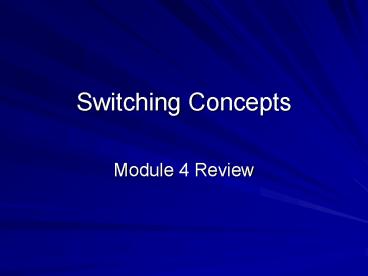Switching Concepts - PowerPoint PPT Presentation
1 / 18
Title:
Switching Concepts
Description:
Layer 2 devices make forwarding decisions based on Media Access Control (MAC) physical ... sending data, then wait for a random period of time before attempting ... – PowerPoint PPT presentation
Number of Views:70
Avg rating:3.0/5.0
Title: Switching Concepts
1
Switching Concepts
- Module 4 Review
2
4.1.1 Ethernet/802.3 LAN Development
- A hub is a Layer 1 device and is sometimes
referred to as an Ethernet concentrator or a
multi-port repeater. - A hub does not make any decisions when receiving
data signals it only amplifies the data signals
that it receives and distributes it through all
ports. - Bandwidth is shared among all connected users.
3
4.1.1 Ethernet/802.3 LAN Development
- Layer 2 devices are more intelligent than Layer 1
devices. - Layer 2 devices make forwarding decisions based
on Media Access Control (MAC) physical addresses
contained within the headers of transmitted data
frames. - Bridge
- Switch
4
4.1.4 Half-duplex Networks
- As more hosts are added to the network and begin
transmitting, collisions, and jam signals
increase. Throughput decreases.
5
4.1.4 Half-duplex Networks
- When a collision occurs, the host that first
detects the collision will send out a jam signal
to the other hosts. Upon receiving the jam
signal, each host will stop sending data, then
wait for a random period of time before
attempting to retransmit. The back-off algorithm
generates this random delay.
6
4.1.9 Full-duplex Transmitting
- Full-duplex Ethernet offers 100 of the bandwidth
in both directions. - This produces a potential 20 Mbps throughput,
which results from 10 Mbps TX and 10 Mbps RX.
7
4.2.2 LAN Segmentation with Bridges
- The bridge must examine the destination address
field and calculate the cyclic redundancy check
(CRC) in the frame check sequence field before
forwarding the frame. - Bridge handling of packets
- The source MAC address and input interface pair
are added to the Bridging Table - If no match to the destination MAC address is
found in the Bridging Table, the frame is flooded
out all other interfaces. - If a match to the destination MAC address is
found in the Bridging Table, the frame is flooded
out the associated interfaces.
8
4.2.3 LAN Segmentation with Routers
- Routers segment broadcast domains.
- Forward packets based on the destination network
layer address. - Segment collision domains.
9
4.2.4 LAN Segmentation with Switches
- LAN switching decreases bandwidth shortages and
network bottlenecks, such as those between
several workstations and a remote file server. - A switch will segment a LAN into microsegments
which decreases the size of collision domains. - However all hosts connected to the switch are
still in the same broadcast domain. - Switches are faster than bridges because the
switching occurs in the hardware.
10
4.2.5 Basic Operations of a Switch
- Switching is a technology that decreases
congestion in Ethernet 10Base-T, Token Ring, and
Fiber Distributed Data Interface (FDDI) LANs. - Latency is the period of time from when the
beginning of a frame enters to when the end of
the frame exits the switch
11
4.2.7 Layer 2 and Layer 3 Switching
- Layer 2 switching looks at a destination MAC
address in the frame header. The source MAC
address is used to build the switching table. - The switching table is contained in Content
Addressable Memory (CAM).
12
4.2.8 Symmetric and Asymmetric Switching
- Asymmetric switching enables high bandwidth to be
dedicated to the server switch port in order to
prevent a bottleneck. - Memory buffering is required on an asymmetric
switch. - The use of buffers keeps the frames contiguous
between different data rate ports. - An asymmetric LAN switch provides switched
connections between ports of unlike bandwidth,
such as a combination of 10 Mbps and 100 Mbps
ports.
13
4.2.9 Memory Buffering
- Shared memory buffering deposits all frames into
a common memory buffer which all the ports on the
switch share. - This allows the packet to be received on one port
and then transmitted on another port, without
moving it to a different queue.
14
4.2.10 Two Switching Methods
- Fast-forward Fast-forward switching offers the
lowest level of latency. This is used by Bridges
15
4.3.1 Functions of Ethernet Switches
- The CSMA/CD access method prevents multiple users
on an Ethernet network from transmitting at the
same time.
16
4.3.2 Frame Transmission Modes
- The hybrid mode is called adaptive cut-through.
In this mode, the switch uses cut-through until
it detects a given number of errors. Once the
error threshold is reached, the switch changes to
store-and-forward mode.
17
4.3.2 Frame Transmission Modes
18
4.3.9 Switches and Broadcast Domains
- A MAC address of all ones is FFFFFFFFFFFF in
hexadecimal.































